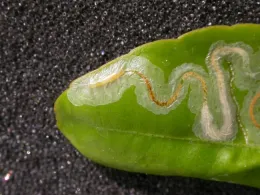Valley Citrus Growers Brace for New Pest, and Ugly Trees
October 31, 2006

For most, citrus leafminer will likely be nothing more than a nuisance, since research from Florida has not linked this pest to any reductions in yield or quality of fruit. However, it is unlikely that there are many farmers who get pleasure seeing the beautiful leaves in their orchards become all twisted and knurled. The real problems with citrus leafminer are while the trees are in the nursery and during their first one to three years of development after planting. During this time citrus leafminer, which loves to feed inside new flush leaves, can cause sufficient distortion and damage to caused stunting of the plants. Damage to nursery plants may also result in regulations regarding movement of nursery plant material and decreases in sales to homeowners.

There is very little citrus growers in the San Joaquin Valley can do to stop the spread of citrus leafminer. All current indications suggest that the pest is moving naturally, and not as a result of the movement of nursery plants or fruit from areas south of the San Joaquin Valley. This explains why very small infestations in Kern County have been found in multiple citrus orchards along Highway 166, as well as in the Arvin, Edison, and General Beale production areas. The likely source of these infestations is adult moths that flew (likely wind-aided) over the hill from areas around Castaic (Magic Mountain) where this pest is reported to be in high numbers in some backyard trees.
As this pest becomes established throughout the San Joaquin Valley, control strategies in mature citrus will involve a combination of biological control and tolerance. Despite how bad trees may look, research out of Florida suggests that there are no negative impacts on yield or quality of fruit, and that this pest can therefore be ignored. As for biocontrol, it is anticipated that a native parasitoid, Cirrospilus coachellae, that currently attacks citrus peelminer will attack and provide some suppression of citrus leafminer. However, the level to which it is controlled is uncertain. There are also other candidate parasitoid species that are being considered for importation into California.
The major concern is for control programs in nurseries and young orchards. Control programs in these situations will likely be chemically intensive, and efforts are underway to develop and document the best management options available.
Additional information regarding citrus leafminer can be found at Dr. Beth Grafton-Cardwell's website at http://citrusent.uckac.edu.
Media groups searching for images of citrus leafminer damage can click on either of the two thumbnails below to download high quality images for publication. Photo credits are to David Haviland, UCCE.
